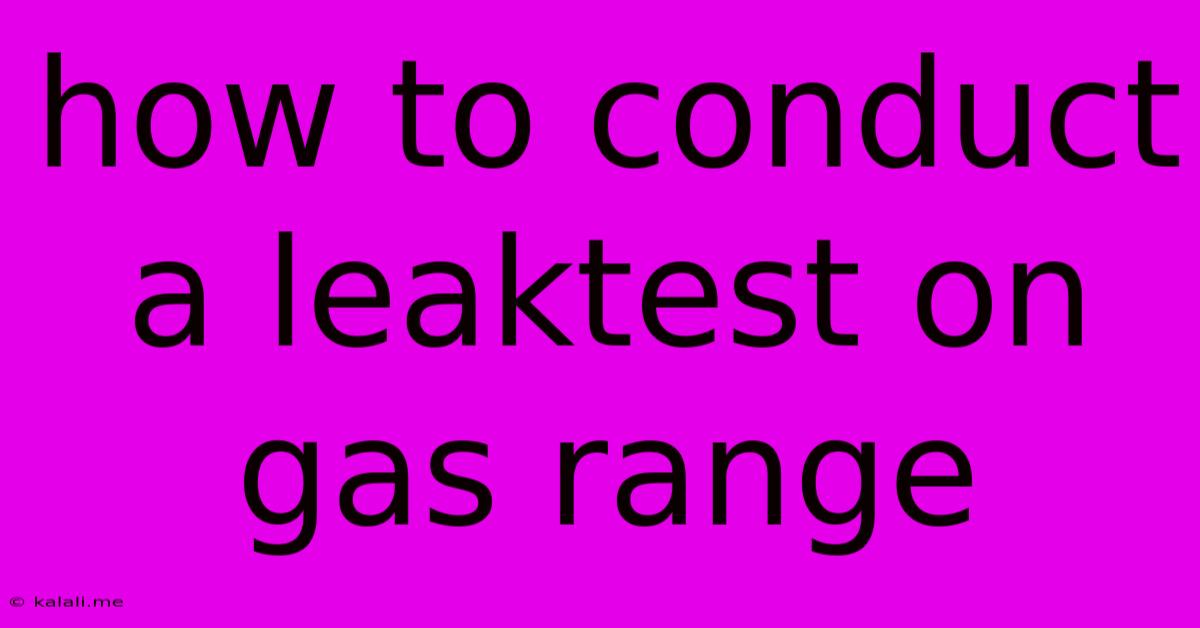How To Conduct A Leaktest On Gas Range
Kalali
May 23, 2025 · 3 min read

Table of Contents
How to Conduct a Leak Test on Your Gas Range: A Comprehensive Guide
Meta Description: Learn how to safely and effectively conduct a leak test on your gas range to prevent gas leaks and ensure your family's safety. This step-by-step guide covers everything from gathering supplies to interpreting results.
Gas leaks are a serious safety hazard, and regular leak testing of your gas range is crucial for preventing potential accidents. This comprehensive guide will walk you through the process of conducting a thorough leak test, ensuring the safe operation of your appliance. While this guide provides valuable information, remember that professional inspection is always recommended if you are unsure or uncomfortable performing this task yourself.
What You'll Need:
Before you begin, gather the necessary supplies. You'll need:
- A spray bottle filled with soapy water: A simple solution of dish soap and water works perfectly. Avoid using harsh detergents.
- A soft cloth or sponge: For applying the soapy water.
- A small container of gas range cleaner (optional): Cleaning the area beforehand improves the accuracy of the test.
- A gas range owner's manual: This will provide specific instructions for your model.
Step-by-Step Leak Test Procedure:
-
Safety First: Always turn off the gas supply to your range before starting the leak test. This is usually a valve located near the appliance or on the main gas line. Never conduct a leak test with the gas turned on.
-
Clean the Area: Clean the area around the gas connections and burners with a gas range cleaner and a soft cloth. This ensures that you can see any bubbles that form clearly. Remove any debris or grease that might interfere with the test.
-
Apply Soapy Water: Using your soapy water solution and a soft cloth, generously apply the mixture to all gas connections on your range. This includes the connections to the gas supply line, the individual burner connectors, and any other gas fittings. Pay close attention to all joints and seals.
-
Inspect for Bubbles: Carefully observe the soapy water for the formation of bubbles. Even small bubbles indicate a gas leak. Large bubbles signify a more significant leak and require immediate action.
-
Identify the Source of the Leak: If you detect bubbles, carefully note the location. This will help you pinpoint the source of the leak and determine the necessary repairs. Remember to carefully document the location of leaks.
-
Turn the Gas On (briefly): Once the visual inspection is complete, briefly turn the gas supply back on to your range. This will ensure you can effectively test all components under pressure. Again, observe the areas for any bubbles immediately. If you find leaks, immediately turn off the gas supply.
-
Interpreting the Results:
- No bubbles: This indicates no detectable gas leaks.
- Small bubbles: Indicates a minor leak that may require tightening connections or replacing a worn gasket. Consult a professional for repairs.
- Large bubbles: Indicates a significant leak requiring immediate attention. Turn off the gas supply immediately and contact a qualified gas technician.
What to Do if You Find a Leak:
If you find a gas leak, regardless of its size, immediately turn off the gas supply to your range. Then, follow these steps:
- Ventilate the area: Open windows and doors to allow fresh air to circulate.
- Avoid using electrical devices or creating sparks: This could ignite the gas and cause a fire.
- Contact a qualified gas technician: Do not attempt to repair the leak yourself unless you are properly trained and certified.
Preventative Maintenance:
Regular maintenance can help prevent gas leaks. Consider these tips:
- Regular cleaning: Keep your range clean and free of debris.
- Inspect connections: Visually inspect gas connections regularly for any signs of damage or looseness.
- Professional inspection: Have your gas range inspected by a qualified technician at least once a year.
This comprehensive guide should help you perform a leak test safely and effectively. Remember, safety is paramount. If you're unsure about any step, or if you detect a leak, always contact a qualified gas technician. Your safety and the safety of your family are the top priority.
Latest Posts
Latest Posts
-
Brown Sludge In Water Softener Tank
May 23, 2025
-
Multiple Outlets Not Working But Breaker Not Tripped
May 23, 2025
-
Where Do I Find Dragons In Skyrim
May 23, 2025
-
Can I Bring Water On A Plane
May 23, 2025
-
Error Casting Generic Object To Type Java
May 23, 2025
Related Post
Thank you for visiting our website which covers about How To Conduct A Leaktest On Gas Range . We hope the information provided has been useful to you. Feel free to contact us if you have any questions or need further assistance. See you next time and don't miss to bookmark.